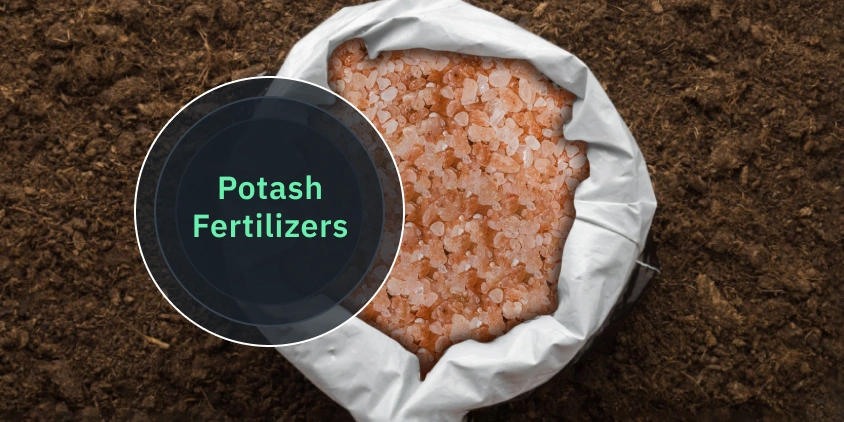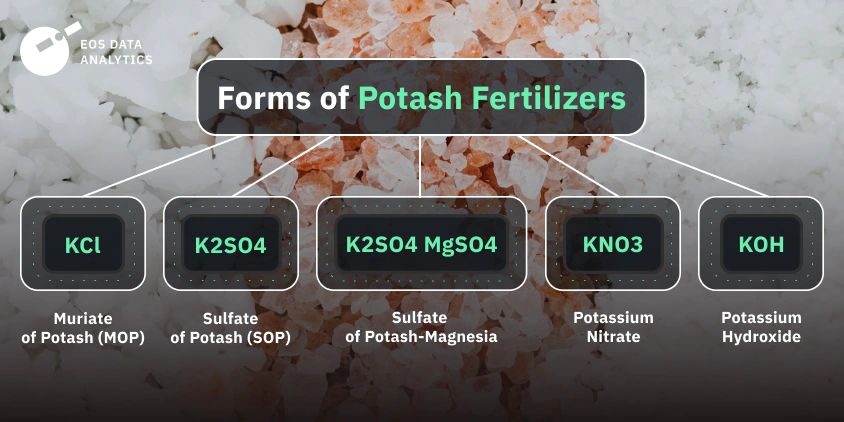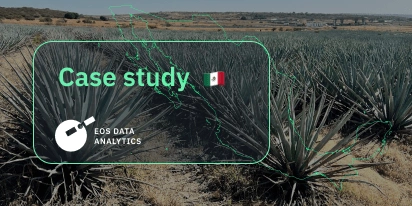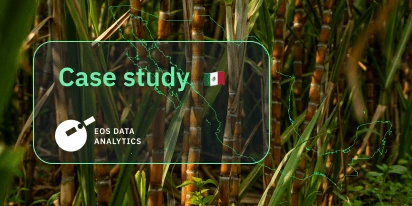
Potash Fertilizers: How And When To Apply Sustainably
Commercial agriculture relies on potash fertilizers to supply crops with potassium — the nutrient essential for enhancing yield potential and product quality. These fertilizers support critical plant functions, from photosynthesis to disease resistance. Different types of fertilizers and application methods are available to accommodate different agricultural strategies and soil conditions. Digital farming has transformed potash use, with online platforms enabling precision variable rate applications based on geo-referenced soil data and crop requirements. As agriculture strives to increase productivity sustainably, efficient use of potassium fertilizers becomes crucial, allowing large-scale farmers to meet global food demands without depleting soil fertility.
What Is Potash Fertilizer And Its Role For Plants?
Potash fertilizer, essential for plant growth, has evolved from its wood ash origins to become a cornerstone of modern agriculture. Today, potash primarily refers to potassium-based fertilizers like potassium chloride and potassium sulfate, mined from vast natural salt deposits, such as those left by the Devonian Sea in Central Canada and the Northern United States.
Potash fertilizers are crucial in maintaining soil fertility and crop yields, especially in areas with intensive agriculture. Potassium (K) plays multiple roles in plant health, supporting water and mineral transportation, activating enzymes, and enhancing photosynthesis. As crops deplete soil potassium over time, regular potash application becomes essential.
The amount of potash needed varies by crop and soil type, making soil testing a critical practice for optimal application. While potash reserves are abundant, efficient use is important for both economic and environmental reasons. By applying potash wisely, for example, through variable rate fertilizing, farmers can improve crop quality, water use efficiency, and plant resistance to pests and diseases.
Types Of Potash Fertilizers
Fertilizers with potassium vary in composition, solubility, and secondary nutrient content, which means different choices suitable for different fertilization strategies. These differences become particularly relevant when dealing with challenging soil conditions, sensitive crops, or specific nutritional goals. By matching the right potash type to their particular needs, growers can optimize their fertilizer budgets and crop outcomes.

Muriate Of Potash (MOP)
Commercial growers often turn to muriate of potash (MOP), also known as potassium chloride, as their go-to potash fertilizer. This water-soluble compound, one of the most concentrated (0-0-60) and the cheapest form of potassium, is effective across various crops, including sugar cane, fruits, and vegetables. In pasture-based agriculture, muriate of potash is commonly mixed with single superphosphate (SSP) for comprehensive nutrient delivery.
While MOP’s uniform granule size ensures consistent spreading, crucial for efficient large-scale fertilization, growers must be aware of fertilizer’s limitations. MOP is not recommended for salt-sensitive crops or areas with high soil salinity. Additionally, unless the seeds are lime-coated or inoculated, they should not come into contact with this potassium-based fertilizer.
Sulfate Of Potash (SOP)
Sulfate of potash, also known as potassium sulfate, is a premium K fertilizer that offers unique benefits for industrial growers seeking to optimize crop nutrition while managing soil and water challenges. The key benefit of this 0-0-50 fertilizer is that it provides both potassium and sulfur in plant-available forms. SOP’s chloride-free composition, meaning a lower salt index, and three times lower solubility compared to muriate of potash, justify its higher price in the next situations:
- fields with sodic or saline soils;
- irrigation water high in chloride;
- cultivation of chloride-sensitive crops, such as berries and vines.
Sulfate Of Potash-Magnesia
Sulfate of potash-magnesia, or potassium-magnesium sulfate, is a water-soluble substance, providing potassium, magnesium, and sulfur in one package. Langbeinite is a natural source of this potassium fertilizer. Its unique composition addresses multiple plant needs simultaneously, improving chlorophyll synthesis and enhancing phosphorus uptake. Potassium-magnesium sulfate’s denser particles result in a slower dissolution rate than other potassium-based fertilizers, which means more sustained nutrient delivery .
This type of feeding is especially effective in sandy, low-cation soils, maintaining a neutral pH while treating magnesium and sulfur shortages. With a chloride content below 3%, it’s gentler on young plants than many alternatives and minimizes the risk of seedling burn.
Potassium Nitrate
Potassium nitrate with a 13-0-45 NPK ratio is a versatile fertilizer, providing nitrogen and potassium in readily available forms. This feeding excels in situations requiring a chloride-free, easily soluble source of nutrients. The nitrogen in this substance is immediately available as nitrate, which eliminates the need for soil microbial conversion. This characteristic is especially beneficial for high-yielding crops that prefer the nitrate form of nitrogen over ammonium.
The water-soluble crystalline form of potassium nitrate is ideal for hydroponics, particularly when growing salt-sensitive crops. The granular form of the fertilizer offers easier handling and more controlled release for soil applications.
Potassium Hydroxide
Agriculture producers looking for alternatives to MOP in terms of high concentration should consider potassium hydroxide (0-0-70). This chloride-free K source is ideal for plants sensitive to chloride ions. Its high water solubility facilitates quick nutrient absorption, while its alkaline properties help neutralize acidic soils (in their uppermost layer). To maximize effectiveness, evenly apply potassium hydroxide-based fertilizers near plant roots.
With a variety of potash options available, growers can fine-tune their fertilization strategies for optimal results. Regardless of the type of potash fertilizer you use, proper timing and application methods are crucial.
Potash Fertilizer Application: Timing And Practices
Getting the most out of K in fertilizer takes more than just spreading the substance across fields. The proper application timing, coupled with the appropriate method, can significantly boost crop productivity. Here’s what you need to know to get it right.
When To Apply Potash Fertilizer
While potassium is less prone to loss than nitrogen, proper application timing can still impact its availability to plants. The following factors influence the ideal timing for potassium-rich fertilization:
- Soil nutrient levels. For very low soil K levels, fall application may be preferable. However, spring application is equally effective in most cases.
- Soil properties. Soils with low cation exchange capacity, typically sandy or coarse-textured, may benefit from potash application shortly before planting. This timing helps reduce the risk of K leaching before crop uptake.
- Application frequency. Biennial applications can be as effective as annual ones. However, for specific crop types and field conditions, the residual effect on the second year will not be sufficient to meet crop nutrition needs and sustain desired yields.
- Starter potash fertilizer use. When applying starter fertilizer with K, limit the total potassium nitrate to 80 lbs/acre (90 kg/ha) to avoid salt injury. If you need higher rates, broadcast and mix the additional potash into the soil before planting.
- Harvest and post-harvest practices. Both silage harvesting and crop residue removal increase K removal rates. To reduce nutrient loss, consider delaying these operations and adjusting fertilization timing and rates accordingly.
How To Apply Potash Fertilizer
Commercial growers have three main options for potash application: banding for targeted delivery, broadcasting for uniform distribution, and foliar sprays for rapid absorption. The choice depends on crop type, soil conditions, and equipment availability.
Broadcasting
Broadcasting is the simplest method for applying potash fertilizer. It involves spreading dry or liquid potash evenly across the soil surface, typically before planting. While generally practical, this technique works best for rapid operations and high application rates.
Farmers can leave the fertilizer on the surface, relying on rain or irrigation to wash it in. However, mechanical incorporation is advised. Depending on the desired depth, tools like harrows, cultivators, or ploughs can mix the potash into the soil’s upper layer, ensuring better nutrient distribution and availability for crops.
Banding
Banding — injecting or depositing K fertilizers in narrow bands below or to the side of the seed — is a practical way to apply potash, especially in challenging soil conditions. It’s particularly useful in heavy, compacted, or wet soils that struggle to warm in spring, as well as in fields with generally high but uneven potassium levels. Conservation farmers who use reduced tillage methods frequently opt for banding during planting.
Notably, banded applications are effective at just half the rate of broadcast spreading, thus maintaining yields at lower input costs. For growers facing soil challenges, banding provides a precise and cost-effective solution for potassium fertilizer management.
Foliar Application
You can apply potash solutions directly to plant foliage as a supplement to broadcasting or banding. This method, known as foliar application, enables swift K uptake and is particularly effective for addressing deficiencies identified through visual inspection or leaf analysis.
While it can’t replace traditional soil fertilization, foliar spraying offers advantages like low application rates and uniform nutrient distribution. To avoid leaf damage, applications should occur during cooler periods with higher humidity (for instance, early in the morning). Muriate of potash, with its high salt content, is not the best option for foliar use because of its potential to harm plant tissues.
EOSDA Crop Monitoring eliminates the guesswork in potash applications, bringing precision to your fields. Our P&K fertilization maps tap into years of satellite imagery to highlight differences in productivity across your land. This insight allows you to apply K fertilizer where it’s needed most, thereby minimizing input waste with lesser soil testing costs. By fine-tuning your approach to potash fertilizer application with EOSDA’s P&K fertilization maps, you’re paving the way for increased yields and more cost-effective farming overall.

Environmental Benefits Of Potash Fertilizers
Agricultural potassium fertilizers possess a unique environmental advantage. Unlike nitrogen and phosphorus, potassium doesn’t contribute to air and water pollution even when applied in excess. For commercial farmers, this translates to reduced environmental risks and greater application flexibility.
However, K deficiency can decrease other nutrients’ use efficiency. This is particularly true for nitrogen, potentially resulting in nitrate leaching . Thus, maintaining optimal soil potassium levels is crucial for maximizing nutrient uptake, crop yields, and environmental safety. Give a try to our precision farming solutions for savvy crop producers that make balancing soil nutrients a breeze for healthier crops and land.
About the author:
Kateryna Sergieieva has a Ph.D. in information technologies and 15 years of experience in remote sensing. She is a Senior Scientist at EOSDA responsible for developing technologies for satellite monitoring and surface feature change detection. Kateryna is an author of over 60 scientific publications.
Recent articles

Digital Tools Improve Soil Health And Yields In Mexico
EOSDA and ITTA supported a Guanajuato farm with contour-line planning, monitoring tools, and practical guidance to reduce soil erosion and improve yields in the long run.

Analyze 2025 & Plan Your Best Year Yet: LandViewer Christmas Offer
It’s the most wonderful time of the year! The Christmas holidays are here, and so is your chance to analyze 2025 and plan a prosperous 2026 with more affordable Pro plans in LandViewer.

EOSDA Models Climate Change Impact On Sugarcane Yields
EOSDA modeled future temperature, rainfall, and other climate impacts on Veracruz sugarcane. The results help growers plan long-term adaptation strategies, including timing, varieties, and irrigation.